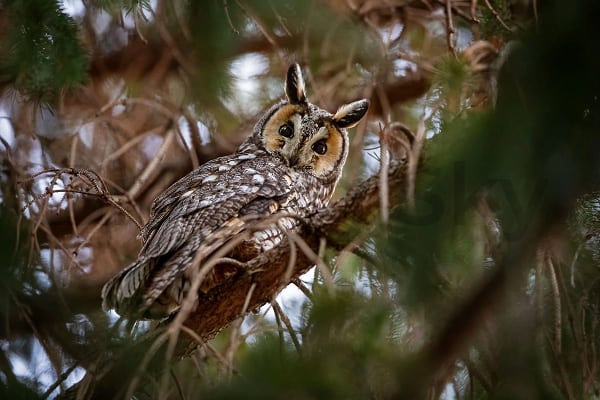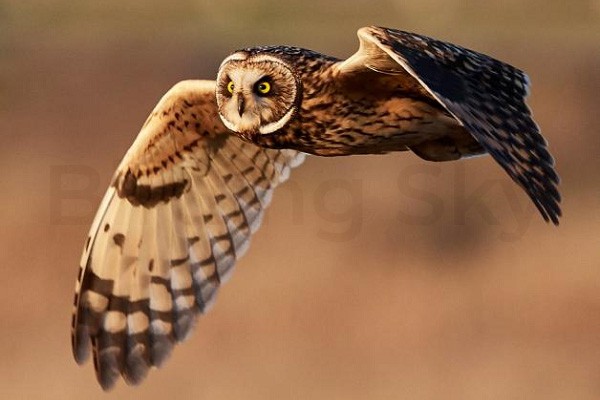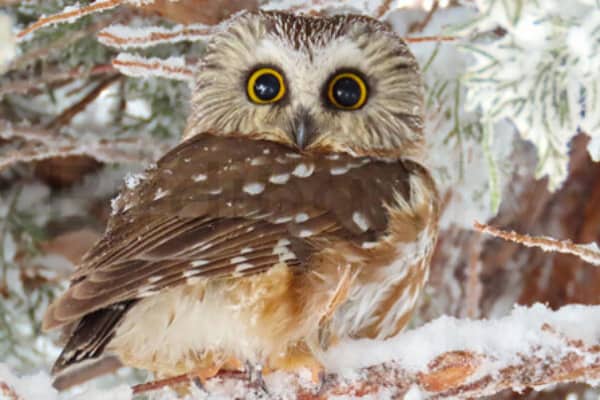Have you ever wondered about the fascinating world of owls and their presence in Alabama? The mesmerizing hoots, the silent flights, and the captivating eyes – owls have captured the hearts and imaginations of humans for centuries. But did you know that Alabama is home to not just one or two, but seven different species of owls?
Can you identify all seven species of owls that grace the skies of Alabama? Do you know what makes each owl unique, from their distinct calls to their preferred habitats? Join us as we uncover the secrets of these mystical creatures and provide you with an in-depth look at the owls of Alabama.
Key Takeaways:
- Discover the seven diverse species of owls that call Alabama home.
- Learn to identify each owl, from their physical characteristics to their calls.
- Explore their habitats, behaviors, and hunting techniques.
- Gain a deeper appreciation for the role these owls play in Alabama’s ecosystem.
- Immerse yourself in the enchanting world of owls and their natural beauty.
1. Barn Owl
The Barn Owl is a fascinating owl species that can be found in Alabama. With its distinctive white and light-brown feathers and heart-shaped face, it is easily recognizable. This owl is known for its remarkable silent flight, which allows it to approach its prey undetected. Its exceptional hunting skills make it a formidable predator.

In Alabama, the Barn Owl is one of the seven species of owls that you can encounter. Its unique features and behaviors make it an intriguing bird to study and observe.
The Barn Owl’s habitat varies, but it typically prefers open grasslands, agricultural fields, and marshes. It can also be found in abandoned buildings, barns, and hollow trees. This species has adapted well to human-made structures and often nests in man-made owl boxes.
When it comes to hunting, the Barn Owl primarily preys on small mammals such as rodents, shrews, and voles. Its keen sense of hearing allows it to locate its prey in complete darkness. Once it spots its target, it swoops in with precise and swift movements to capture its meal.
Let’s take a closer look at the key identification features of the Barn Owl:
Key Identification Features of the Barn Owl:
- Heart-shaped face
- White and light-brown feathers
- Long, pointed wings
- Slender body
- Effortless and silent flight
Understanding the distinctive characteristics of the Barn Owl can help you identify and appreciate this magnificent owl species when you encounter it.
“The Barn Owl’s silent flight and exceptional hunting skills make it a master of the night. Its heart-shaped face and beautiful plumage add to its charm.”
| Barn Owl | Eastern Screech Owl | Great Horned Owl |
|---|---|---|
| Distinctive white and light-brown feathers | Small size and ear tufts | Prominent ear tufts and piercing yellow eyes |
| Heart-shaped face | Camouflage plumage | Large size |
| Effortless and silent flight | Variety of calls, including the “whinny” sound | Hooting call |
| Preys on small mammals | Feeds on insects, small mammals, and birds | Diverse hunting techniques and diet |
Comparing the Barn Owl’s features and behaviors with other owl species can provide a deeper understanding of their unique adaptations and ecological roles.
Must Read Owls in Louisiana
2. Eastern Screech Owl
The Eastern Screech Owl is a small and adaptable owl species found in Alabama. With its distinctive ear tufts and camouflage plumage, this owl is known for its variety of calls, including its classic “whinny” sound.

Eastern Screech Owls are typically found in forested areas, where they can easily hide among the trees during the day. They have a wide range of preferred habitats, including deciduous forests, urban parks, and suburban areas. This adaptability allows them to thrive in various environments throughout Alabama.
The diet of the Eastern Screech Owl mainly consists of small mammals such as mice, voles, and shrews. They are also known to feed on birds, insects, and occasionally reptiles. Their hunting techniques are quite impressive, and they rely on their excellent hearing and silent flight to catch their prey by surprise.
In addition to their remarkable adaptation skills, Eastern Screech Owls possess unique characteristics that set them apart. Despite their small size, they have a fierce demeanor and can be quite territorial when it comes to defending their nesting sites. Their ability to blend into their surroundings with their camouflage plumage makes them masters of disguise.
If you’re lucky enough to hear an Eastern Screech Owl, you’ll be treated to a range of vocalizations. Besides the distinctive “whinny” call they are known for, they also produce trills and soft hooting sounds. These calls serve various purposes, including territorial defense and attracting mates.
Overall, the Eastern Screech Owl is a fascinating species that adds charm to Alabama’s bird diversity. Its adaptability, variety of calls, and unique characteristics make it a captivating creature to observe and learn about.
Also Read Owls in Massachusetts
3. Great Horned Owl
The Great Horned Owl is a majestic and powerful predator that can be found in Alabama. Recognized by its large size, prominent ear tufts, and piercing yellow eyes, this owl is known for its hooting call and ability to adapt to diverse habitats.
This impressive species of owl has a wingspan of up to 5 feet and stands around 2 feet tall, making it one of the largest owls in Alabama. Its feathers are a mixture of brown, gray, and white, providing excellent camouflage in various environments.

The Great Horned Owl’s hunting techniques are exceptional. With keen eyesight and incredible hearing, it can locate and capture its prey with precision and accuracy. This owl is known to hunt a wide range of animals, including small mammals, birds, and even reptiles.
The Great Horned Owl is also known for its nesting habits. It typically nests in abandoned nests of other large birds, such as hawks or crows. The female owl lays 1-4 eggs, which hatch after about a month of incubation. The young owls, known as owlets, stay with their parents for several months, learning essential hunting and survival skills before venturing out on their own.
While the Great Horned Owl is a common sight in Alabama, spotting one can still be a thrilling experience. So, if you’re out exploring nature, keep an eye and ear out for this remarkable owl species. You may just catch a glimpse of its majestic presence.
Related Owls in Africa
4. Barred Owl
The Barred Owl is a medium-sized owl species that can be found in the enchanting forests of Alabama. With its dark eyes, horizontal barring on the chest, and rounded head, this owl is easily recognizable. One of the distinctive features of the Barred Owl is its unique call, often described as “who cooks for you”.

When it comes to habitat preferences, the Barred Owl tends to favor mature forests near water sources, such as swamps, marshes, and rivers. These areas provide the perfect environment for the owl to hunt its preferred prey, which includes small mammals like mice, squirrels, and rabbits, as well as birds and amphibians.
The mating behavior of Barred Owls is also fascinating. They form monogamous pairs, and their courtship displays involve hooting and duetting with each other. The female owl typically lays 2-4 eggs in a tree cavity or abandoned nest, and both parents take turns incubating the eggs and caring for the young.
If you’re lucky enough to spot a Barred Owl in Alabama, take a moment to admire its beautiful markings and listen to its distinct call. These nocturnal creatures play an important role in maintaining the balance of their forest ecosystems, and their presence adds a touch of mystery and wonder to the natural landscapes of Alabama.
Also explore Owls in Minnesota
5. Long-eared Owl (Asio otus)
The Long-eared Owl, also known as the “Northern Long-eared Owl,” is a medium-sized owl species that can be found in Alabama’s woodlands, forests, and marshes. With its rusty-brown plumage, streaked underparts, and distinctive long ear tufts, this owl earns its name. It is mostly active during twilight and can often be spotted perched on tree branches.

The Long-eared Owl primarily feeds on small mammals, such as voles and mice, but may also consume birds and insects. It has a silent flight, allowing it to surprise its prey effectively. When threatened, this owl relies on its camouflage and remains motionless, blending into its surroundings. The Long-eared Owl is a non-migratory species and forms small breeding colonies.
6. Short-eared Owl
The Short-eared Owl, also known as the “Marsh Owl” or “Dusky Owl,” is another owl species found in Alabama’s grasslands, meadows, and marshes. With its mottled brown plumage, yellow eyes, and short ear tufts, this owl is well-adapted to its open habitat. It can often be seen flying low over the ground, hunting for prey.

The Short-eared Owl primarily feeds on small mammals, such as voles and mice, as well as birds and insects. It has a unique hunting technique called “quartering,” where it flies low and back and forth over an area, searching for prey. This owl is also known for its distinctive flight display, involving steep dives and aerial acrobatics.
Unlike the Long-eared Owl, the Short-eared Owl is a partially migratory species, with some individuals traveling south during the winter months. It nests on the ground, creating a scrape in the vegetation or using abandoned nests of other birds.
Although the Long-eared Owl and the Short-eared Owl share similar habitats and physical features, there are key differences between the two species. While the Long-eared Owl is primarily active during twilight, the Short-eared Owl is more diurnal, being active throughout the day. Additionally, the Long-eared Owl tends to occur in denser woodlands, while the Short-eared Owl thrives in open grasslands and marshes.
7. Northern Saw-whet Owl
The Northern Saw-whet Owl is a small owl species that can be spotted in the woodlands of Alabama. With its compact size and round head, this owl is easily identifiable. It is named after its distinctive call, which resembles the sound of a saw being sharpened.

Despite its size, the Northern Saw-whet Owl is an adept hunter. Its diet primarily consists of small mammals, such as mice and voles, making it an essential part of the ecosystem for keeping rodent populations in check.
When it comes to nesting, the Northern Saw-whet Owl prefers tree cavities, where it lays its eggs and raises its young. These owls are known for their secretive nature, often seeking shelter in dense foliage during the daytime and being more active at night.
If you’re lucky enough to spot a Northern Saw-whet Owl in the wild, remember to admire it from a distance and respect its natural habitat. These owls are a beautiful reminder of the diversity and wonder of Alabama’s avian inhabitants.
Frequently Asked Questions
Q1: What is the most common owls in Alabama?
The Eastern Screech Owl is the most common owl in Alabama.
Q2: Are owls protected in Alabama?
Yes, owls are protected in Alabama under state and federal regulations.
Q3: Are there owls in Birmingham?
Yes, Birmingham, Alabama, is home to various owl species.
Q4: What is the smallest owl in Alabama?
The Elf Owl holds the title for the smallest owl in Alabama.
